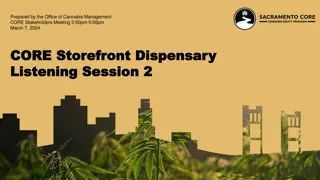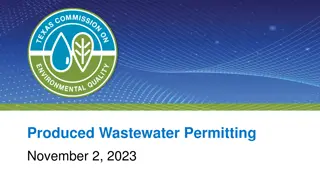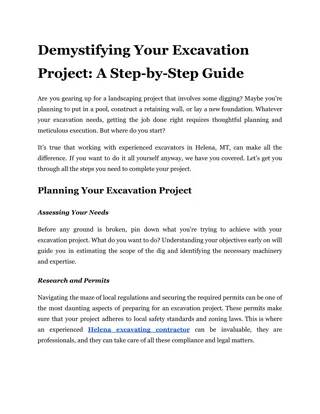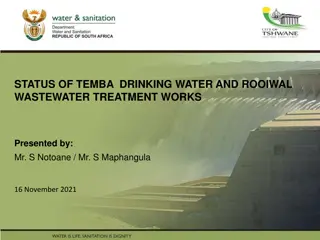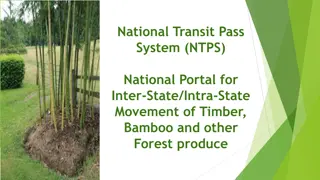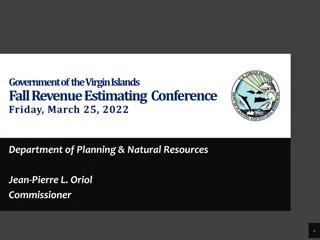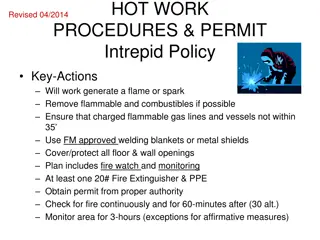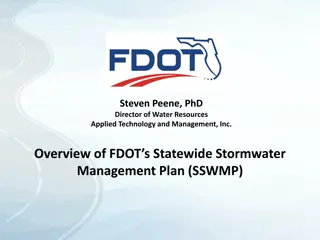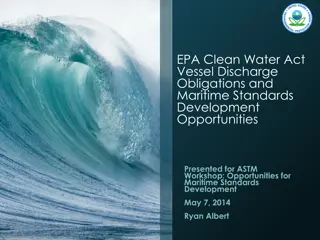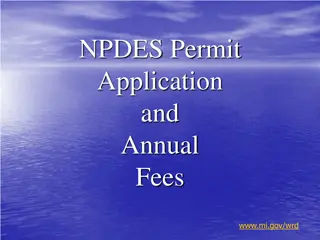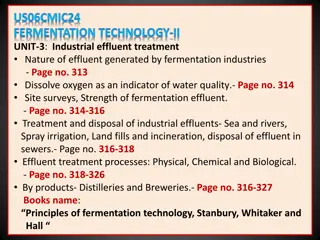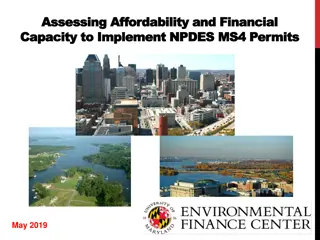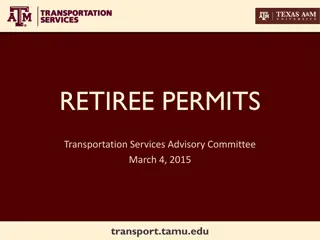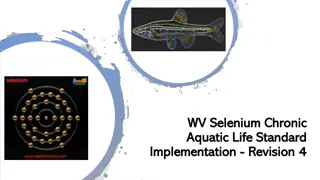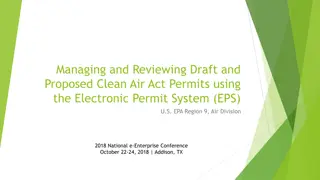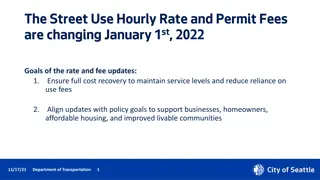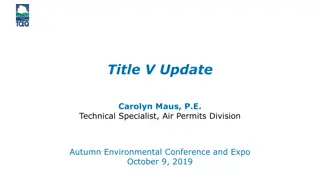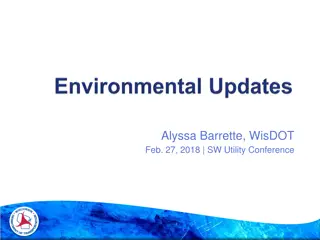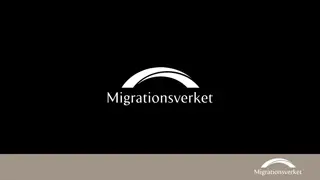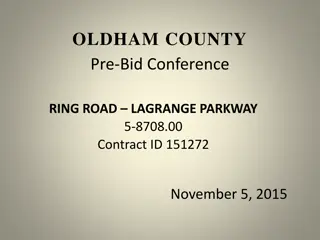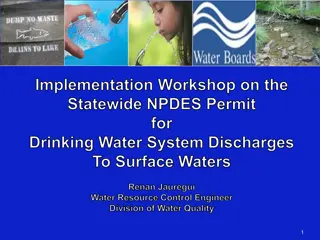Understanding NPDES Permits and Effluent Limitations
NPDES permits authorize discharge and must meet effluent limitations to protect water quality. Beneficial uses, standards, and limitations are crucial for compliance. Effluent limitations are necessary to prevent exceedance of water quality standards, with triggers for implementation.
Download Presentation

Please find below an Image/Link to download the presentation.
The content on the website is provided AS IS for your information and personal use only. It may not be sold, licensed, or shared on other websites without obtaining consent from the author. Download presentation by click this link. If you encounter any issues during the download, it is possible that the publisher has removed the file from their server.
E N D
Presentation Transcript
prgrsvimghttp://ts1.mm.bing.net/th?id=H.4593000514128230w=103h=103c=8pid=3.1qlt=90prgrsvimghttp://ts1.mm.bing.net/th?id=H.4593000514128230w=103h=103c=8pid=3.1qlt=90 http://ts1.mm.bing.net/th?id=H.5020852248644160pid=1.7w=184h=182c=7rs=1 http://ts2.mm.bing.net/th?id=H.4570400405193537pid=1.7w=224h=164c=7rs=1 Implementation Workshop on the Statewide NPDES Permit for Drinking Water System Discharges To Surface Waters Renan Jauregui Water Resource Control Engineer Division of Water Quality 1
image002 scroll_feather What is an NPDES Permit? An NPDES permit is an authorization to discharge There is no right to a permit and it can be revoked 5-year lifecycle Report of Waste Discharge or NOI is needed to apply Issued as an individual or general permit confused
NPDES Permit Policy Our Tool Box California Toxics Rule 126 priority pollutants criteria California Ocean Plan Implementation Objectives California Thermal Plan State Implementation Policy for priority pollutants Implementation Basin Plans Beneficial uses Water quality objectives Implementation
NPDES Permit Nuts and Bolts Major Permit Requirements: Federal Standard Provisions Effluent Limits Technology Based Effluent Limits 40 CFR 405-499 Water Quality Based Effluent Limits WQ Criteria/Objectives (Beneficial Uses) Self Monitoring Requirements Applicable Pretreatment, Sludge, and management requirements, and special studies.
How do beneficial uses relate to standards and limitations If MUN applicable: Protect it for drinking water standards (MCLs, CTR human health) If REC-1 applicable: Protect it for pathogens (total coliform standards, and CTR human health as well) If AGR applicable: Protect it for AG goals and Pathogens if direct consumption If COLD or WARM applicable: Protect it for toxic pollutants (CTR aquatic toxicity for metals and pesticides), chlorine and ammonia toxicity, dissolved oxygen, temperature, pH, etc.
Effluent limitations are needed where there is a reasonable potential for the discharge to cause or contribute to an excursion above water quality standards. We have a three-trigger reasonable potential test. Effluent limitations could be for: Individual constituents Whole effluent toxicity Effluent limitations can result in Increased monitoring & reporting costs $ Special studies (dilution, tox evaluation) $$ Penalties & liability $$ Additional controls or advanced treatment $$$
Carl Henriet - SWRCB Intake Supply Reasonable Potential Analysis Ambient B 1. 2. Limit if: Max Eff Conc Criteria Limit if: Max B > Criteria and detected in effluent Limit possible if: impaired, fish tissue, compliance problems, etc. 3. DISCHARGER Criteria C Effluent 1 2 3 4 5 6 7 5 Concentration
DWS NPDES Permit Enrollment Who is required to enroll Water Purveyors that are Community Drinking Water Systems (CDWS) with 1000 connections or more Wholesalers regardless of the number of connections Who would not be required to enroll Community Drinking Water System with less than 1000 connections. Transient, non-transient and non-community drinking water systems. CDWS that are also MS4 Permittees. CDWS that have an established MS4 local agreement and approved by their local Regional Board. CDWS whose discharges do not enter a water of the U.S. CDWS whose system-specific or water-body specific discharges require an individual Regional Board NPDES permit due to a TMDL or because the discharge falls outside the scope of the statewide permit. 8
DWS NPDES Permit Authorized Discharges Type of Discharges Authorized (sample list) Planned Groundwater supply well flushing or pump to waste Groundwater well development, rehabilitation and testing Transmission system installation Distribution system storage tank or reservoir releases Distribution system dewatering, flushing, pressure testing Fire hydrant flushing, meter testing, automated water quality analyzers operations. Water Treatment plant operations (excluding backwash filter that discharges to a water of the U.S.) Discharges due to activities undertaken to comply with mandates of the Federal Drinking Water Act and Ca Health and Safety Code Emergency and Unplanned Drinking water system failures, including repairs on transmission or distributions system failures Trench dewatering due to a system failure or emergency failure Operation errors and discharges due to catastrophic events. 9
DWS NPDES Permit Effluent Requirements Effluent Requirements/Limitations for discharges that enter a water of the U.S. Establish Best Management Practices (BMPs) to: Prevent aquatic toxicity of chlorine by dechlorination Prevent erosion and hydromodification by erosion control and prevention measures Minimize Sediment discharge and turbidity impacts through sediment, turbidity, and erosion controls Prevent water quality impacts from groundwater supply well operations such as well development and rehabilitation by complying with a turbidity action level of 100 NTU or less in the discharge, and change or enhance BMPs when turbidity levels are greater than 100 NTU Applicable to all planned discharges that enter a water of the U.S. Comply with the following effluent limitations: A total chlorine residual maximum of 0.019 mg/L (inland waters, enclosed bays and estuaries) or 0.08 mg/L (ocean) with compliance assessed by a field meter monitoring result of <0.1 mg/L (non-detect) Only applicable to superchlorinated discharges, direct discharges, or discharges within 300 ft from a water of the U.S. 10
DWS NPDES Permit Effluent Requirements Types of BMPs are left to the discretion of the CDWS (include but not limited to those established by AWWA) Emphasis on BMPs to be the primary control of toxicity, solids, trash, erosion, scour and hydromodification BMPs listed in Attachment C of the permit are examples 11
DWS NPDES Permit Monitoring Requirements Monitoring requirements. Event effluent monitoring: (per event) Superchlorinated discharges (volume, chlorine, pH, and visual turbidity) High volume discharges (1ac-ft or larger) (volume, chlorine, visual turbidity) Well development /rehabilitation (volume, chlorine, and metered turbidity), If discharge <20 min then one sample during first 10 min If discharge between 20 to 60 min then one sample first 10 min and second sample during last 10 min. If discharge >60 min then one sample first 10 min, second within 50 min and last one within last 10 min of discharge or close to end of discharge as feasible. Representative effluent monitoring: (annual- chlorine, volume, visual turbidity) All other types of discharges that represent same general water source, same water treatment, and same type of implemented BMPs. Same frequency as event monitoring dependent on duration of discharge. Receiving water monitoring: Visual monitoring (erosion, discoloration, suspended matter, aquatic life impact, visible films, sheens, potential nuisance conditions) Only applicable when direct planned discharges do not comply with permit requirements. (not applicable for emergency discharges). 12
Emphasis on Beneficial Use or Reuse No monitoring is required if water is put to a beneficial reuse such as: Using the water that would otherwise be discharged for irrigation or other uses (e.g dust control) Putting the water that would otherwise be discharged to land disposal for ground water infiltration and recharge 13
DWS NPDES Permit Reporting Requirements Notification/Reporting requirements. Notification of emergency or noncompliant discharges Notify Regional Board within 24 hrs and in writing within 5 days Notify Stormwater System Operator with 24 hrs. Pre-Notification of large planned discharges >1acre-ft: Notify Regional Board and Stormwater System Operator 3 days prior to initiating discharge or retroactively within 24 hrs after the Discharger is informed to initiate a large volume discharge Reporting to State Water Board by March 1 of every year: All non-compliant discharge monitoring information A record of the number of direct discharges that are >50,000 gal for the year An estimate of the total volume discharged to waters of the U.S. during the year. An estimate of the total volume of discharged water that was put to a beneficial reuse instead of discharging to a water of the U.S. 14
NPDES Permit Application Checklist Notice of Intent form completed and signed Application fee payable to the SWRCB included Site information provided Option of providing general location of the facilities or the boundaries of the service area(s) Need only to show the named receiving waters and the major named downstream waters For discharges within 300 feet of a water body, the Discharger is only expected to submit the representative distance of 300 feet on both sides of the named water bodies or indicate the entire service area is within 300 feet from a water body. TMDL Waterbody information completed and submitted 2 samples laboratory analysis for parameters listed in Table F-2 for each applicable TMDL waterbody The estimated minimum and maximum discharge volume per discharge event and estimated average annual discharge volume going to the TMDL waterbody. Description of TMDL specific BMPs if any. 15
NOI Example Water Watch Website http://drinc.ca.gov/DWW/index.jsp 16
NOI Example Sections 1, 2 17
NOI Example Sections 3, 4 18
NOI Example Section 5 19
NOI Example Section 6 20
NOI Example Section 7 http://www.waterboards.ca.gov/water_issues/programs/tmdl/integrated2012.shtml 21
NOI Example Section 8 22
NOI Example Certification/Signature 23
Mapping Requirements DWS Geographic Tool http://www.ehib.org/page.jsp?page_key=61 24
Notice of Non-Applicability Discharges from the drinking water system solely enter a water of the U.S. via a municipal separate storm sewer system (MS4) and there is a local agreement established with the MS4 Permittee and approved by the local Regional Water Board. The drinking water system is owned or operated by the MS4 Permittee and all discharges enter a water of the U.S. via the permitted MS4 system. The drinking water system is regulated under an existing individual Regional Water Board Permit due to threat to water quality above the low-threat scope of the statewide permit, or due to the need to address TMDL-specific requirements. The drinking water system does not discharge to a water of the U.S. or a conveyance that drains to a water of the U.S. 25
Notice of Non-Applicability submittal Checklist Notice of Non-Applicability form completed and signed Regional Board Order and NPDES number included if reason for NONA is that the discharge falls outside the scope of the statewide permit. Copy of local agreement with an MS4 permittee and acknowledgement by the Regional Board is included if reason for NONA is that the discharge is covered under a local agreement with MS4 permittee. Regional Board Order and NPDES number is included if reason for NONA is that the discharger is owned and operated by an MS4 permittee or co-permittee which is named in the MS4 permit. Description how discharges are managed if reason for NONA is that no discharge enters a water of the U.S. 26
prgrsvimghttp://ts1.mm.bing.net/th?id=H.4593000514128230w=103h=103c=8pid=3.1qlt=90prgrsvimghttp://ts1.mm.bing.net/th?id=H.4593000514128230w=103h=103c=8pid=3.1qlt=90 http://ts1.mm.bing.net/th?id=H.5020852248644160pid=1.7w=184h=182c=7rs=1 http://ts2.mm.bing.net/th?id=H.4570400405193537pid=1.7w=224h=164c=7rs=1 Questions? Questions? 27


